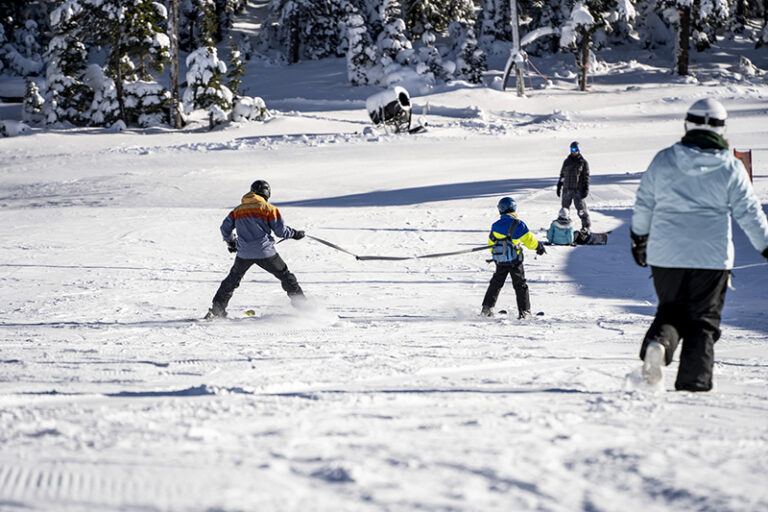Over the years, I’ve discovered that there is no such thing as dry and warm for long, vigorous rides in bad weather. And because most high-tech fabrics start with promises of “warm and dry,” which I’ve never actually experienced, I’ve developed an aversion to most high-tech clothing. I like wool. Sometimes I’ll wrap a cheap shell over the wool to keep the heavy rain off me. But generally, many layers of thin wool always keep me warm, if not dry.
Enter Schoeller fabric. It’s a fancy, high-tech fabric from Switzerland. Although it’s been around for years, I finally found it last winter. Schoeller is a woven fabric with some stretch. It’s super comfortable and water resistant. Unlike non-woven coated nylon, Schoeller actually breathes. It cuts wind pretty well and dries very fast.
Schoeller is very durable, or as they say in the technical-clothing-speak, “abrasion resistant.” I wore the same pair of Schoeller-fabric pants almost daily during last years’ winter. The pants are still looking good and they’re ready for another winter.
The water resistance is interesting in that the fabric is not coated with water repellant chemicals that break down over time. According to the clothing geeks on backpackinglight.com, the water resistance is a by-product of the woven structure of the fabric, which does not provide a surface for water to rest, so the fabric is slow to absorb water. I can vouch for the water resistance. A downpour will get you wet, but most Spokane sprinkles and quick cloud bursts will not wet the fabric.
Lots of clothing manufacturers use Schoeller fabric. Ibex, Arc’Teryx, REI, and Northface are just a few.
I bought the REI Acme pants ($159) a year ago. While expensive, these pants have proven to be a great value. They look normal compared to bike-specific pant alternatives and they’re plenty warm down to about 35 F. When it’s colder, I wear long underwear and I’m happy down to the 20’s. I have a pair of the REI Mistral pants ($89), made from a lighter version of Schoeller that I wear when it’s not cold enough for the Acmes. The black Mistrals would pass for dress pants in low light. They’re super comfy and very light; I’ll wear them up to 70 F or so.
As it turns out, my favorite winter cycling jacket of all time also uses Schoeller-like fabric. I’ve written a number of times about the Ibex Dash Hybrid jacket. The jacket has a soft-shell wind and water resistant front made from “Climawool.” Climawool is a herringbone woven fabric that has many of the same qualities of Schoeller. The back of the jacket is made of a woven wool and spandex blend. So the front keeps the wind and moisture out, while the back of the jacket lets the heat escape while keeping you happy and warm.
I forever pledged my allegiance to the Dash Hybrid on a rainy 80 mile ride last fall where the average temperature was 38 degrees. I was damp but warm the entire time. No other jacket has ever performed like that for me.
The Dash Hybrid is a great jacket, so I was bummed when it fell out of the Ibex lineup a year ago. I wrote to Ibex and asked why they dumped the jacket. The response was that a new and better version was on the way in 2009. So, a couple months ago, when the 2009 Vim Hybrid was introduced, I wrote again to Ibex and asked if they would send me a jacket to review.
I’ve been using the jacket for a month or so and here’s the skinny. The Vim Hybrid ($195) is a great 3-season, all purpose jacket. Like all things Ibex, the jacket is extremely well-made, looks nice, and is super comfortable.
Unfortunately however, it’s not an improvement on the Dash Hybrid. The Vim Hybrid is a much thinner jacket than the Dash; I can’t get it to keep me warm in temperatures under 30 F without adding too many layers under it. For a cycling jacket, I want a form-fitting jacket that feels good with one or two thin layers underneath. With the Vim, to stay warm in the cold, I have to add too much bulk. The Dash, on the other hand, is weighted for colder weather. Two thin layers under the Dash are all I ever need to stay warm down to the teens.
Another disappointing aspect of the Vim Hybrid is that it’s not cycling specific. Unlike the Dash, which is cut a bit lower in the back, the Vim is a traditional cut, which exposes a bit of my lower back when I ride. The Vim also lacks the rear pocket. And instead of a small chest pocket the Dash has (perfect for a phone or an mp3 player), the Vim has two traditional hip pockets, which I think is the crummiest place for pockets on a cycling jacket.
I think the Vim would make a great 3-season, all-purpose jacket and I look forward to trying it out for early spring rides and trail running to see how it holds up to warmer and rainier days. But my plea to Ibex is to bring back the Dash Hybrid. The world needs a cycling-specific, technical, wool winter jacket, and the Vim is not it.
John Speare grew up and lives in Spokane. He rides his bike everywhere. Check out his blog at http://cyclingspokane.blogspot.com.













